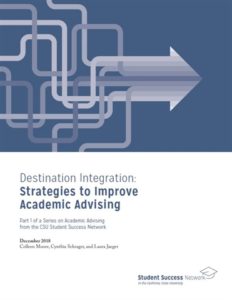
Many campuses across the California State University (CSU) system are seeking to improve academic advising as part of their efforts to increase student progress and graduation rates. In this exploratory study of efforts to improve academic advising at five CSU campuses, researchers at the Education Insights Center (EdInsights) working on behalf of the CSU Student Success Network identified a focus across the participating campuses on better coordinating advising services across colleges, divisions, and departments and improving their integration with other campus units, such as tutoring, career centers, and financial aid. Through their efforts, these campuses seek to better leverage their limited advising resources to improve student outcomes. This report, based on in-depth interviews with 36 administrators involved in improving advising, describes the campuses’ efforts and the context in which they are occurring.
As is the case at many universities across the country, academic advising services at CSU campuses are often distributed, or decentralized, across multiple divisions and offices. While this decentralized structure is valued for its support of departmental autonomy and variation in advising approaches in response to local contexts, it poses a significant challenge to ensure adequate communication and coordination across advising units.
Across the campuses we studied, we found five strategies to improve coordination and leverage limited resources, most of which are at early stages of implementation. All five campuses are utilizing:
- advising councils, committees, task fources, and summits;
- eAdvising tools;
- professional development training and events; and
- shared positions or cross-functional advising teams.
And, four of the five campuses are utilizing:
- a senior administrator with campuswide advising oversight.
Most of the campus strategies are in the early stages of implementation, and information to evaluate their impact are not available. The administrators we interviewed, however, said that they believe these efforts have the potential to improve relationships across units that have not had a strong history of effective collaboration.
Destination Integration is the first of two reports on academic advising in the CSU system. The second part, Destination Integration: Perspectives of Students and Advisors about Improving Academic Advising, can be found here.
View or Download PDF

